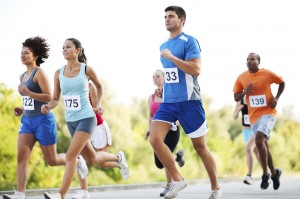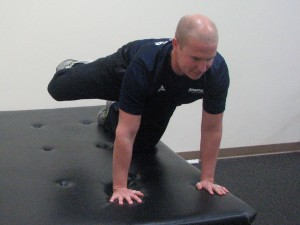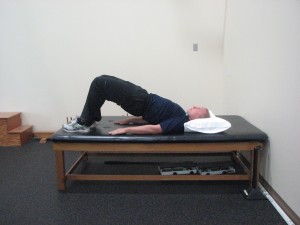Now that spring is here and it is beautiful outside, a lot of runners really begin to build their mileage. When this happens, I usually start to see a lot of hip flexor pain and tightness. This problem is really common in distance runners. Tight hip flexors are a major cause of many posture problems. In runners, it is mainly caused by repetitive use and weak glutes. In people who sit a lot, well, it is caused by sitting a lot. This posting covers what to do if you are running a lot.

The main purpose of the hip flexor is to bring the thigh up towards the stomach. When the hip flexors are excessively tight, they cause exaggerated pelvic anterior tilt (the person sticks his or her butt out and the lower back arches). The upper back curves and rounds, and the person’s chin can stick out and “lead” in front. Sometimes tight hip flexors can begin to do the abdominals’ work and make it difficult to benefit from some abdominal exercises. Tight hip flexors cause the primary hip extensors, the gluteal group, to become lengthened and weaker.
One big contributing factor to hip flexor tightness is that the glutes just aren’t as active as other running muscles during most activities. This causes your hamstrings, quadriceps, and calves to become much stronger. Also, let’s face it, do most people have a strength-training program that isolates and increases glute strength? Probably not. Most of us do squats and lunges and call it a day. However, if an exercise requires several muscles to perform the movement, most of the work is done by the strongest of those muscles and those aren’t your glutes.
The good news is that you don’t need to join a gym, buy a lot of expensive special stuff, or even leave your house to remedy the situation. There are a lot of body weight and resistance band exercises and stretches that you can do at home that will help you resolve this problem. Here they are!
STRETCHING
Remember to dynamically stretch BEFORE exercise and statically stretch AFTER exercise.
I call my number one, go-to hip flexor stretch the Pirate Stretch. It is very easy, and I call it the Pirate Stretch because, well, you look like a pirate when you do it.
- Stand up with feet even.
- Step forward into a lunge.
- Bend and lower your back knee. Keep your lunging knee over your ankle.
- Hold for 20-30 second.
- Do it on the other side.
- Remember that you should only stretch to mild tension!
FOAM ROLLING (AKA: Self-Myofascial Release)
Foam rolling is a form of massage that enables you to release the tension of your muscles by yourself. Let it be noted that I LOVE foam rolling. I am a total geek about it. That said, if you are tight and are new to foam rolling, when you first start it will probably hurt. Keep at it, it really works.
- Lay on the roller right below your hip angled out.
- Roll back and forth on the roller until you find the tight spot.
- Sit on the tight spot for 20-30 seconds. Find the next spot and repeat.
EXERCISES

Fire hydrants
- Begin by placing both hands and knees on the floor; your back should form a tabletop.
- Keep both legs bent in a 90-degree angle and toes flexed throughout the duration.
- While keeping hips forward, lift your right leg out to the side until it is parallel to the ground or at maximum height. Pause and bring leg back to start position.
- Repeat for 12 reps and repeat with the opposite leg.

Bridging
- Begin this exercise while lying on your back with both knees bent at about a 45-degree angle and both feet flat on the floor.
- Let your arms rest at your sides.
- Slowly lift the hips by pushing on the floor with your feet until your knee, hip, and shoulder are a straight line.
- Repeat for 12 reps.
Lateral band walks
- Put resistance band on above each ankle.
- Separate feet slightly as you get into a 45-degree angle squat with your abs tucked (feel like you are trying to touch your belly button to your backbone).
- Step laterally.
- Keeping your shoulders even, bring other foot in towards the lead leg to finish your step.
- Repeat in the same direction for the length of the room.
- Return to the other side of the room facing the same direction.
Lateral Walks Lateral Walks
Monster walk
- Put resistance band on above each ankle.
- Separate feet slightly as you get into a 45-degree angle squat with your abs tucked (feel like you are trying to touch your belly button to your backbone).
- While staying down low in the ready position, bring one leg out and forward then swing this leg out laterally to the side. You will “pull” the leg out to the side against the resistance of the stretched ankle band as you finish each step.
- Bring the other foot forward towards the lead leg, then go right into the next step. Keep feet separately slightly during transition in order to maintain band tension. Do not allow band to get loose.
- Repeat in the same direction for the length of the room.
These stretches and strengthening exercises will keep you fresh and on the move throughout the endurance season. If you do them consistently, you will feel much better before, during, and after your runs.
If you would like to learn more about hip flexor tightness from an Athletico physical therapist, please use the button below to schedule a complimentary injury screen at a clinic near you.
The Athletico blog is an educational resource written by Athletico employees. Athletico bloggers are licensed professionals who abide by the code of ethics outlined by their respective professional associations. The content published in blog posts represents the opinion of the individual author based on their expertise and experience. The content provided in this blog is for informational purposes only, does not constitute medical advice and should not be relied on for making personal health decisions.
Original article and pictures take www.athletico.com site
No comments:
Post a Comment